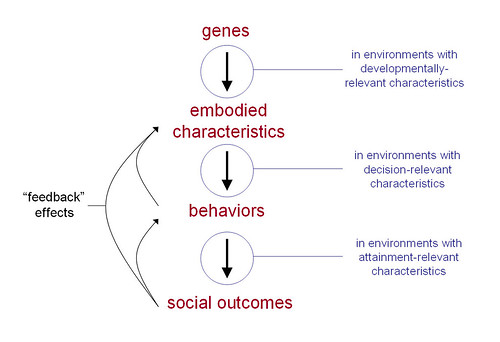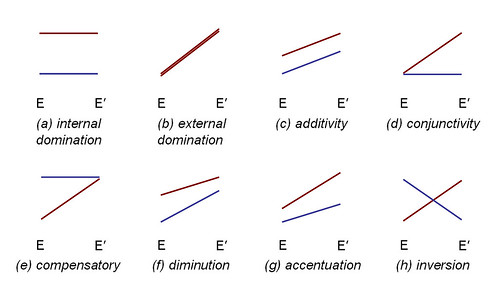The three basic genres:

1. How do a person’s genes and environments combine to produce the embodied characteristics (e.g., the psychology) of the person?
2. How do those embodied characteristics interact with the circumstances of the immediate situations to produce actions?
3. How do the actions of individuals interact with the structure of the networks and societies in which they are part to produce biographical attainments?
Note: more properly, one should add "at a particular point in biographical time" before the question mark for each question.
The eight basic plots:

The red and blue lines are different genotypes or phenotypes or some-as-yet-unknown-word (agencies?). E is the default environment, and E' is the environment with some natural or artifical intervention.
As if we were talking about genes -> embodied characteristics, the eight plots briefly:
(a) Different genotypes cause different outcomes that are the same across environments.
(b) Different genotypes produce the same outcome that depends on the environment.
(c) Genes and environments both have effects, and the effects of each are not affected by the other.
(d) Environmental cause only has effect for some genotypes.
(e) Genes produce different outcomes in the normal environment, but under a compensating environment produce the same outcome.
(f) The environmental cause makes the effect of genes less than it would otherwise be.
(g) The environmental cause makes the effect of genes greater than it would otherwise be.
(h) Different genes do better or worse in different environments.
Anyway, if somebody ever asks you to think about "genetics and social structure" and you start doing background reading, you'll find that you are soon reading about debates about genes v. environment, person v. situation, agency v. structure. These are very different things. And, yet, you do have a entity and a substrate in which a transformation of the entity occurs and the project of telling a story about how the character of the entity and the character of the substrate caused the transformation to happen as it did.
9 comments:
Even if you replace people with cells that you can manipulate without worrying about IRB approval, those are very hard questions to answer.
I hadn't thought about it like that before, but I like that there's a kind of self-similarity between levels.
I'm very interested in hearing how you could connect causes and effects on such different scales.
I am starting to get the feeling that you are on a trajectory such that, 10 years from now when I see you at the ASA, I will whisper to my friends that I used to know you when you were just a Harvard postdoc. Maybe I will pop into the business meeting of the Freesian Sociogenetics section and sit in the back row.
awesome!!! Keep truckin' on this.
1. The lower line in (b) should be blue.
2. Labeling the plots (a) ... (h) and the key (1) ... (8) made baby Jesus cry.
3. I think this representation is too complex, and somewhat confusing because it mixes a number of different things together. You're partly taxonomizing the way some external context affects the action or expression of some causal mechanism (eg in a and b). But you're also trying to show that the context can have independent effects too (e.g. in c). This is further complicated by using two lines, trying to show how a context can have contrasting effects on different causal mechanisms. All this makes the relationship between the lines and the E and E' labels hard to interpet, because in some panels their natural interpretation is Before/After and in others it's Case 1 and Case 2. Really you need to show both the "gene" effects and the "environment" effects as vectors with a third representation of the outcome. Something more like the so-called 'neuron diagrams' in the literature on causal counterfactuals, though not with the same interpretation.
Kieran:
I fixed the red line on my slide (though didn't upload) and rectified the Baby Jesus problem. As for the neuron diagrams, are those the diagrams with the filled and empty circles and arrows in the Collins, Hall, and Paul book?
are those the diagrams with the filled and empty circles and arrows in the Collins, Hall, and Paul book?
Yes. That style is good for tracing kinds of causal dependence. The more I think about it the more I think you are trying to show two different things here.
1) Kinds of causal dependence between entities -- i.e., does G always get expressed regardless of E and vice versa. Do they have a linearly additive effect. Does one make the effect of the other a bit smaller. Etc. In this case you don't really need to represent the genes and the environment (or actions) as nested, you could just show different antecedent circles and their effect on the outcome. Your (a) (b) (c) (f) and (g) are cases under this heading. Introducing two Gs (G1, G2) only makes it more complex.
2) The effect of an intervention in E on the expression of different Gs. E.g., Does E have the same effect on G1 and G2? Your (e) and (h) are cases under this heading. Two Gs are required for these cases.
I sort of dashed off the brief verbal descriptions of what I meant by the different diagrams. I think you are right with the 1 and 2, maybe I can recast my verbal descriptions to always be consistent in terms of #2 by thinking of (a) is being about the environmental cause being inert. I'll need to look back at how those neuron diagrams looked, as I certainly don't remember.
Although I suppose this is a completely predictable response, I fail to see why you haven't simply adopted a counterfactual model completely.
Why not (1) set-up a population stratified by genotype, (2) attach potential outcomes to different states of the environment, and (3) argue for between-strata differences in the causal effects of the environment. It would all be doubly fun with strata further subdivided into a second set of genotypes, at which point inteventions on the environment could produce even more than your 8 cases.
All that being said, what you have presented seems clear enough to me, such that a full-blown potential outcome treatment may not be worth the additional effort.
random: could you put the decision to get plastic surgery through model?
Post a Comment